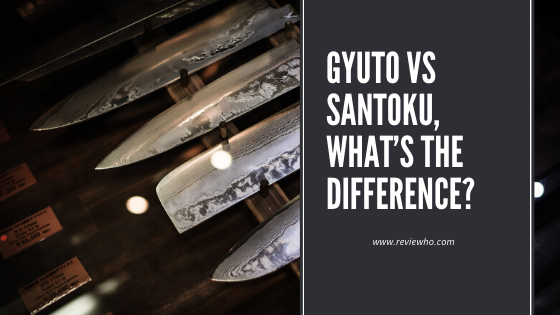Do many people ask what is the difference between Gyuto and Santoku? Well, for their information, there is a huge difference between these two.
As some of them may use it interchangeably, but that totally wrings.
Both of these are popular kitchen knives used by people all over the world, especially by professional chefs.

If you want to become skilled in using them, then you have to understand their difference. For people like you who have no information about their difference, we have compiled this article with Gyuto vs Santoku differentiation is done.
We are sure that you will learn a lot from our information.
General Differentiation Rule
While comparing and making the difference between these two types of kitchen knives, make sure that you select them from the same series and the same manufacturing companies. This will help you stick to the main points that differentiate them.
In another case when you chose different series and different manufacturers, then the whole focus will be diverted towards other factors that are not necessary. These might include the quality of the steel, its sharpness, and its handling ability. So, for effective Santoku vs Gyuto, make sure you keep this general rule in your mind.
Origin
The origin of Gyuto is either German or France. It is believed that it was first discovered in either of these two countries and after few years imported to Japan.
The major purpose behind their discovery was that the bigger chunks of meat could be handled easily with this giant knife rather than the normal smaller ones used in homes.
In the case of the Santoku, the origin is Japan itself where the chefs used it for cutting vegetables. Japan used to have a very famous knife before it was called Nakiri Knife which was very sharp and used to handle vegetables. Based on the idea of this knife, the Santoku originated.
Related:
- Usuba vs Nakiri Knife
- Tips To Keep Your Knife Razor Sharp
- How to Care for and Maintain Your Kitchen Knives
Shape
When we talk about Santoku vs Gyuto, then the shape is a major difference between the two of them. In the case of Gyuto, the shape is not very much curved as in the case of many knives we see used in the western kitchen. also, it features a pointed tip, slightly turned down spin, and curved edge. hence, it has a shaper tip than santoku and that makes it perfect for meat and rock cutting.
While the shape of the Santoku knife is much flatter when compared to the Gyuto. Most commonly, the shape of this knife is known as the sheep foot which means a straight edge and a spine that curves down to meet it at the point. and it is best for slicing and vertical straight chopping.
Blade Length
The blade length of which these knives are made can be any according to the use and the need of the user or chef. If the use is quite a lot and the chef likes to work fast, then usually the longer length is recommended for them as it can give him access to more cutting techniques, while for small home chores of the kitchen, a smaller length can be compromised or used.
In general, the Gyuto knife is made with as much as about 12 inches or 300-millimeter length, while the Santoku is made with as much length as 7 inches or 180 millimeters. They do not exceed this length, so this is how they differentiate in this trait from each other.
Weight
As you explore more Gyuto vs Santoku differences, you come to know that their weight is also different from each other. This is a very simple trait, but they do differ in this case too.
In general, people have the impression that the Gyuto knife is heavier as compared to the Santoku knife. To some extent, this is depended on the type of material from which its handle and blade are made, moreover the thickness, and the length of the blade.
So, if we take them into account, then maybe sometimes Santoku would be heavier, but in general, Gyuto tops this position.
Cutting Technique
Gyuto is known for cutting meat, slicing, mincing, and chopping, but what is specialized Gyuto from santoku in this category is the rocking motion.
However, in the case of the Santoku knife, the major use is chopping, slicing, and mincing vegetables, so there might be no proper technique of cutting used in it.
Which one you should buy?
Now after you thoroughly understand the difference between Gyuto and Santoku, the point to ponder here is which one you should buy and use.
Well, it is generally a personal preference which one a person would pick from both, but here is a simple list of questions which if you answer in favor of one and against the other you can decide which one to pick.

These questions include the following:
- What do you need to cut through your knife?
- Which cutting technique do you follow?
- Do you like a heavy knife or a light one?
- Do you have enough space in the kitchen to place it?
- Do you want to buy it for meat cutting or vegetable cutting?
- Would you like to have a Japanese kitchen knife vibe in your kitchen?
Well, through the above information, it must be now clear in your mind what is the difference between Gyuto and Santoku.
It has been made very clear that in all aspects from cutting to shape to weight and blade length, both are totally different from each other, thus their use is also different. After this detailed discussion, we are sure that you are never going to mix them once again.
Also, read: Can you use a Butter Knife for Cheese?
Comparison Table
| Gyuto | Santoku | |
|---|---|---|
| Lenght | Up to 14 inch | 7 inch or less |
| Profile | Curved egde | Flat profile( sheep's foot blade) |
| Origin | Germany or France | Japan |
| Tip | Sharp pointed tip | Flat tip |
| Tasks | Slicing, mincing, dicing and almost every other job. | Slicing, mincing, and dicing. |
| available Materials | Stainless steel, carbon steel, ceramic | Stainless steel, carbon steel, ceramic |
Feel free to share your observations with me in the comments section!
Also, if you find the information in this post to be useful, be sure to share this post with your friends on Facebook, Twitter, and Pinterest!




